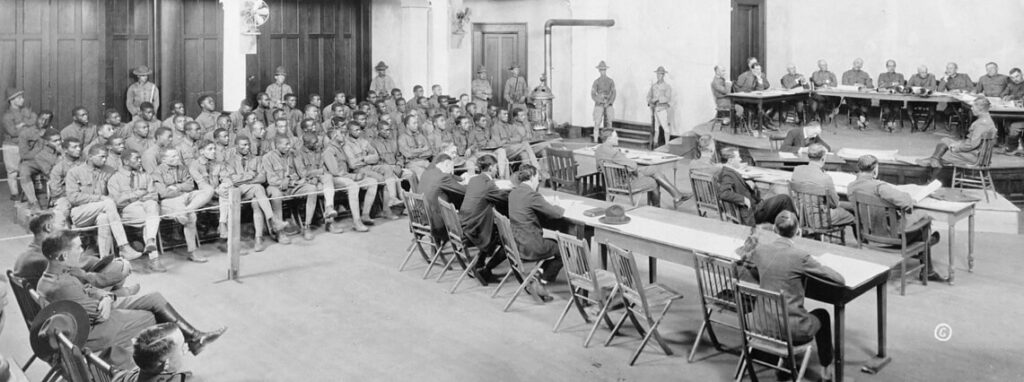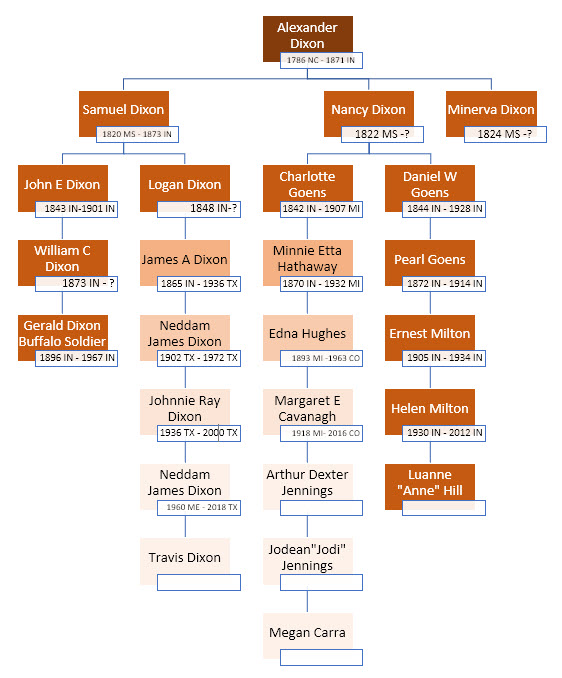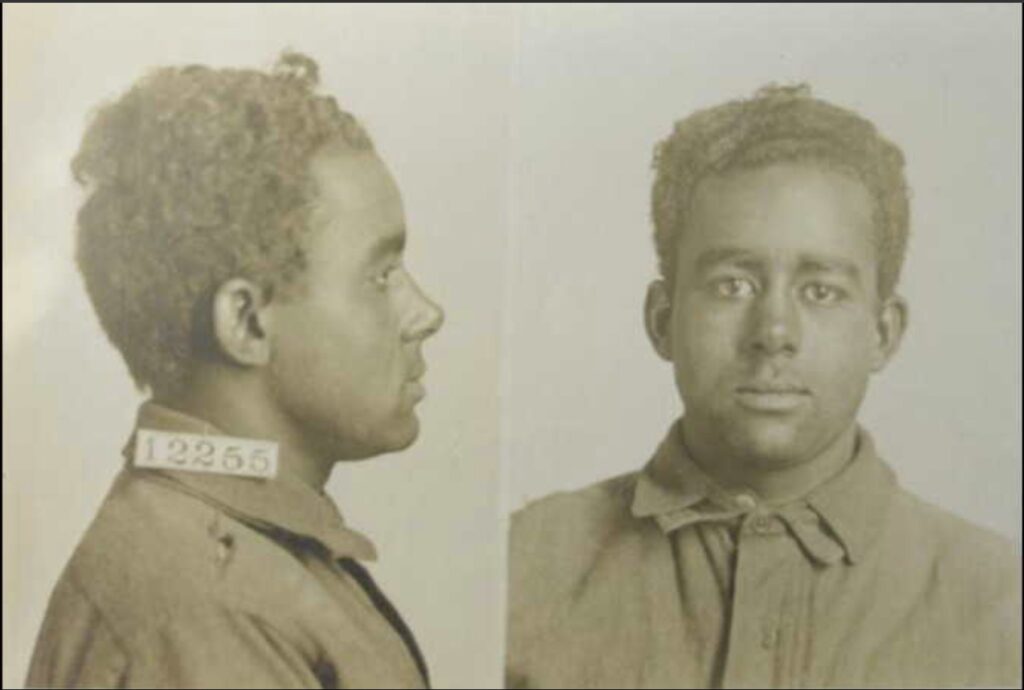Private Gerald Dixon: Buffalo Soldier of the 24th Infantry
One year ago today, I received an out-of-the-blue message on Ancestry.com from a stranger named Mallorie. She had found my family tree on the site and saw familiar names and places related to the Dixon and Mitchell families she was researching. Once I confirmed that our Dixon family line was indeed the same black family from Seymour, Indiana that she was looking for, we connected over the phone and she shared the fascinating project she was working on.
It all started when she was preparing for the application process to get a historical marker for her grandfather, Alonzo Marshall, a well-known black businessman in Marion, Indiana. While digging through his tax returns, she came across a man by the name of Gerald Dixon who worked for her grandfather. She hadn’t seen his name before and discovered with some more investigation that he had served time in the Leavenworth Penitentiary. Wondering (with concern) who this man was, she did a deep dive into his history through records and newspaper articles and what she uncovered was an INCREDIBLE story!
Gerald Dixon was born in Seymour, Indiana in 1896 to parents William C. Dixon and Elizabeth “Libbie” Pierce. At age 6, his parents divorced and two years later, in 1905, his mother married Norvel Mitchell (also a descendent of this Dixon line and a relation to us). Gerald grew up on Tipton Street and attended the Lynn Street Colored School on the corner of Tipton and Lynn Street through the fourth grade {Photo of school in gallery below}. As a teenager, he worked in several different places in Seymour including the New Lynn hotel and the Baltimore and Ohio Railroad division office where he was a janitor. He was an honest and hard worker and all his former employers spoke well of him. On September 28th, 1914, he enlisted in the army in Columbus, Indiana and became part of the infamous 24th Infantry. His battalion was sent overseas to the Philippine Islands where they remained for several months before heading to California and later to Alaska. From Alaska they were transferred to New Mexico and then to Houston, Texas to guard the construction of a new military installation, Camp Logan. If you have watched the Netflix movie, The 24th, you know what happened next. If you haven’t, I’m going to try to summarize the events that took place and what happened to the soldiers and my cousin, Gerald Dixon.
The 3rd Battalion of the all-black 24th Infantry Regiment arrived in Houston, Texas at the end of July in 1917. Their presence was not welcome in the strictly segregated Houston, with Jim Crow laws in place. Not only were they regularly taunted and mocked by members of the community, they were also harassed by several members of the local Houston Police Department (HPD). There were several instances where the police assaulted the soldiers leaving lasting injuries.
On the afternoon of August 23rd, 1917, two members of the HPD, Lee Sparks and Rufus Daniels, entered the predominantly black San Felipe district to disrupt a gathering on a street corner. They fired a few warning shots and then started chasing down some of the men who had fled from the gunshots. One of the officers burst into the home of a local woman looking for the men. When she said she knew nothing of their whereabouts, he dragged her outside her house, not even giving her the chance to put shoes on and arrested her. While the two officers called in the arrest, Private Alonzo Edwards approached them and offered to assist. Instead, he was pistol whipped by the officers and arrested himself. Later that afternoon, Corporal Charles Baltimore approached the two officers looking for Private Edwards. Officer Sparks struck Baltimore with his pistol and then fired three shots at him as he ran away. The officers continued to chase Baltimore and when they found him hiding under a bed in a nearby home, they pulled him out, beat him and placed him under arrest.
After the horrendous ordeal, a rumor made its way back to Camp Logan that the police had shot and killed Baltimore. An officer from the 24th Infantry Regiment was able to retrieve Baltimore from the police station and return him to camp. While they were relieved to see him still alive, upon seeing the state of him, they were still furious. Then, another rumor started that there was an angry white mob heading their way.
After weeks of built-up tension and anger, many of the soldiers of the regiment decided to mutiny and riot against Houston. Armed with weapons from their supply tent, they marched into town seeing nothing but red. They fired at houses and cars. They marched over 2 ½ miles before encountering any police. The HPD had assumed that the soldiers would not be armed and thought that they could quickly subdue the men. This wasn’t the case and when the riot had ended, there were 17 casualties (4 police officers, 2 soldiers and 9 civilians).
The next day, Houston was under martial law and all the soldiers were rounded up and turned over to the US army where they would be soon be court martialed and sentenced for their crimes. There were 13 soldiers who were hanged, 41 were given life sentences and 4 received sentences of 2 ½ years or less. All were dishonorably discharged.

Private Gerald Dixon was one of the 41 soldiers sentenced to life in prison with hard labor at Leavenworth Penitentiary in Kansas. He sentence was later reduced to 20 years. He always claimed his innocence and after serving 7 years, he was released on parole. He moved to Jackson County, Missouri where he married his first wife, Lydia in 1928 and worked as a porter for a grocery store. By 1940, he had moved to Marion, Indiana where he lived a brief time with his mother and stepfather and worked as a butler in a private home. In 1947, he married his second wife, Francis Jones. He worked for the cleaners, Brown-Trueblood Inc. and Marshall’s Recreation Parlor for many years as Alonzo Marshall’s right- hand man. He passed away in 1967 at age 71. His wife Francis lived another 35 years and passed away in 2002. The couple had no children and were buried in the Estates of Serenity cemetery (formerly known as I.O.O.F Cemetery) in Marion, Indiana.
On November 13, 2023, the US Army made the decision to reverse the convictions of the 110 soldiers after admitting that the soldiers were wrongly treated because of their race and not given fair trials. After 106 years, these brave men who served our country and endured more than we can imagine, were given honorable discharges. What an amazing thing!
Fast forward to 2024, when Mallorie made the sad discovery that both Gerald and his wife Francis were buried without headstones and not even buried beside each other. The project of her grandfather’s historical marker was placed temporarily on the back burner, and she channeled all her effort on sharing Gerald’s incredible story and planning an event that would make right this wrong. And with the help of her brother Eric and the Marion community, DID THEY EVER!
Even though Gerald was my 3rd cousin 4x removed (sharing a 6th great-grandfather), she invited me, my mom and my great-aunt Sherla who flew in from the east coast to attend what would be the most incredible and impactful weekend of my life. I had connected with a couple other Dixon cousins through Ancestry.com and this was the perfect opportunity for us all to meet. Cousin Anne is a descendant of both our Dixon and Goins lines and lives in Indianapolis. Cousin Travis Dixon came from Texas and stayed with us in an Airbnb in town. He too had been researching his mysterious Dixon ancestry and like ours, his Dixon line began passing for white a few generations before he was born so he too had been disconnected from the Dixons of Indiana.
Over the weekend of October 26th, 2024, Mallorie had several events planned to honor Gerald. On Saturday, October 26th, there was a formal program at the Walton Performing Arts Center in Marion entitled “Buffalo Soldiers of the 24th: Camp Logan Riots and Marion’s Own Gerald Dixon”. There was a documentary screening, several amazing guest speakers and discussion on the history of the Buffalo Soldiers and the 1917 riot. That evening, we were honored to be invited to a reception entitled “Honoring Legacy Celebrating Unity” at the Kennedy Art Center. We had the opportunity to meet community members, dignitaries, Buffalo Soldiers and more of our extended family. The following morning, we attended a special church service at Bethel A.M.E. Church and then gathered with family for lunch. Cousin Anne and her husband joined, and we had a wonderful time of conversation and discussion of our genealogy research. I had brought my Dixon genealogy binder with a color coded descendancy chart I created to show how we were all related and descendants of Alexander Dixon who was born into slavery in 1786. By the mid 1830’s, he and his partner Margaret and their three mulatto children, Samuel, Nancy and Minerva Dixon ended up in Seymour, Indiana. {Descendancy chart included below}
After lunch, we decided to head over to the Estates of Serenity cemetery to see the gravesite of Gerald and Francis. We also walked around to several other graves of family members ranging from recent relations back to distant aunts, uncles and cousins buried there long ago. We weren’t done spending time together, so we invited everyone back to our Airbnb to sit around the living room and share stories.
On Monday morning, with the permission of the cemetery, Travis and I went to watch as they disinterred Gerald and Francis. Both coffins were encased in concrete vaults, and we watched as they were carefully lifted and placed onto the truck to be transported to their final resting place. An American Flag was draped over Gerald’s vault which invoked an overwhelming amount of emotion for all of us, especially Mallorie.
That afternoon, the festivities began with a vibrant motorcade led by a firetruck and police escort, followed by the Buffalo Soldiers on their motorcycles—riders who had traveled from across the country—and a long line of vehicles filled with family and friends. As we made our way through town, we passed Gerald’s house on Nebraska Street, where Mallorie had placed a sign in the yard featuring his photo, surrounded by red, white, and blue decorations—a heartfelt tribute that brought his presence into the moment.
We arrived at our final destination—Marion National Cemetery—where Gerald would finally receive the proper graveside service he so deserved, complete with full military honors. As we approached, we were overwhelmed by the sight before us: a firetruck stood proudly with a giant garrison flag billowing in the wind, and crowds of community members and students surrounded the shelter in support.
We had the honor of sitting alongside other members of the Dixon family, including his great-niece, our dear cousin Glennis, who—as Gerald’s closest living relative—received his ceremonial folded flag. The service was beautiful, dignified, and everything Gerald had earned through his life and service. We remained at the cemetery until both Gerald and Francis were laid to rest—together again at last.
While it’s been 7 months since I was a part of this incredible event, the memories and feelings of family, inclusion and connection are still with me daily. From the moment we arrived in Marion, we were welcomed with open arms. It didn’t matter that we were all distant cousins. It didn’t matter that we were white. What mattered was that we were family. There was a desire to learn from each other and connect with one another and all I can say is that it was magic. None of this would have been possible without the vision, persistence, and heart of Mallorie. She made this once-in-a-lifetime experience a reality, and we are forever grateful for the gift she gave Gerald and us all.
Below is the descendancy chart I created for the event to be able to easily explain how each Dixon cousin was related to Gerald and each other through our common ancestor Alexander Dixon.

Related News Articles of Gerald's Life and Legacy
Article from 11 Dec 1917, Tue The Atchison Daily Globe (Atchison, Kansas)
Death Penalty Negro Troopers in Houston Riot Cont.
Article from Dec 11, 1917 The Atchison Daily Globe (Atchison, Kansas) Stories and events
Gerald Dixon in "Notes From the Local Field"
Article from Dec 19, 1917 The Chronicle (Scottsburg, Indiana) Stories and events
Article from Dec 19, 1917 Jackson County Banner (Brownstown, Indiana) Stories and events
"Seymour Negro" Gerald Dixon Receives Life Sentence for Taking Part in Houston Riot
Article from Dec 14, 1917 The Times-Mail (Bedford, Indiana) Stories and events
Article from Dec 12, 1917 The Tribune (Seymour, Indiana) Stories and events
Visits Son at Fort Leavenworth Prison
Article from Dec 28, 1917 The Tribune (Seymour, Indiana) Stories and events
Article from Jan 2, 1918 Jackson County Banner (Brownstown, Indiana) Stories and events
Article from Oct 28, 1967 Leader-Tribune (Marion, Indiana) Obituary
Private Gerald Dixon: Buffalo Soldier of the 24th Infantry Read More »

